"We are what we repeatedly do. Excellence, then, is not an act, but a habit." --Aristotle
Address any questions or comments regarding this newsletter to the individual authors listed after each article or to its editor, Rick Weinzierl, 217-333-6651, weinzier@illinois.edu. To receive e-mail notification of new postings of this newsletter, call or write the same number or address.
In This Issue:
Upcoming Programs (for beginning and established growers)
Regional Reports (from St. Charles and from southern and western IL)
Fruit Production and Pest Management (spotted wing Drosophila update PHIs for apple insecticides)
Vegetable Production and Pest Management (pumpkin weed control, corn earworm update)
Local Foods Issues (webinars on new farmers market regulations)
Upcoming Programs
Check the Illinois SARE calendar for a full list of programs and links for registration.
http://illinoissare.org/ and http://illinoissare.org/calendar.php
Also see the University of Illinois Extension Local Food Systems and Small Farms Team’s web site at:
http://web.extension.illinois.edu/smallfarm/ and their calendar of events at http://web.extension.illinois.edu/units/calendar.cfm?UnitID=629.
- Northwestern IL Farm Tour, August 24, 2014. 10:00-11:30 a.m., Hops Production, Bier Blume Hops Farm, Lena, IL. Free and geared towards beginning and experienced growers. Pre-register at http://web.extension.illinois.edu/jsw/; maps to the farms are available at this site. For more information, contact Grant McCarty (gmccarty@illinois.edu) or at 815-235-4125.
- Legal Issues Workshops (for small farms), September 2-9, 2014. 8:00 a.m.- 4:00 p.m. September 2 at the University of Illinois Extension Office in Springfield; September 3 at the University of Illinois Extension Office in Champaign; September 5 in Carbondale at the SIUC Dunn-Richmond Center, and September 9 at the University of Illinois Extension Office in Grayslake. For more information, see http://thelandconnection.org/legalissues.
- Pumpkin Field Day, September 4, 2014. 10:00 a.m. at the Ewing Demonstration Center, Ewing, IL (about 20 minutes south of Mt. Vernon; 4 miles east of I-57) ½ mile north of the Ewing Northern School off of Main Street) For more information contact Nathan Johanning at 618-687-1727 or njohann@illinois.edu.
- Cover Crops, Soil Health, and Value Adding with Diversity, September 4, 2014. 9:00 a.m. to noon, PrairiErth Farm, Atlanta, IL. For more information, see http://web.extension.illinois.edu/units/event.cfm?UnitID=629&EventID=66230.
- Northwestern IL Farm Tour, September 10, 2014. 6:00 – 7:30 p.m., Agritourism with Pumpkins and Apples, Dittmar Farms and Orchard, Elizabeth, IL. Free and geared towards beginning and experienced growers. Pre-register at http://web.extension.illinois.edu/jsw/; maps to the farms are available at this site. For more information, contact Grant McCarty (gmccarty@illinois.edu) or at 815-235-4125.
- Southern Illinois Summer Twilight Meeting Series, September 15, 2014. 6:00 to 8:00 p.m. On farm program at Lipe Orchards, Carbondale, IL. Pre-registration (at no cost) is required; see http://web.extension.illinois.edu/ghhpsw/ or contact Bronwyn Aly at 618-382-2662 or baly@illinois.edu.
- Preparing a New Generation of Illinois Fruit and Vegetable Farmers, December, 2014 – November, 2015. Aspiring farmers, new growers with less than five years’ experience, commodity farmers interested in diversifying to include fruit or vegetable production, and high school and community college agriculture teachers are invited to apply for the next session of a free training program offered by the University of Illinois at Dixon Springs, Urbana, and St. Charles, IL. For more information, see http://newillinoisfarmers.org/ and http://news.aces.illinois.edu/news/new-illinois-farmers-program-accepting-applications-third-session.
- Angelic Organics Learning Center is offering the 2014-15 Stateline Farm Beginnings course. The winter course (October through March) provides ten business planning sessions; additional training events (April –through October) include monthly field days and advising from established farmers. See http://michaelfields.org/wp-content/uploads/2014/06/Stateline-Farm-Beginnings.pdf.
- Mark your calendars … for the Illinois Specialty Crops, Agritourism, and Organics Conference, January 7-9, 2015, at the Crowne Plaza Hotel and Convention Center, Springfield, IL.
Regional Reports
From the July twilight meeting at the St. Charles Horticulture Research Center ... Many of you will recognize the two experts pictured below. Bill Whiteside (left) and Chris Doll (at the wheel) attended and chatted with many who were present. I'm not sure a John Deere Gator ever carried more knowledge and experience than this one did in July.
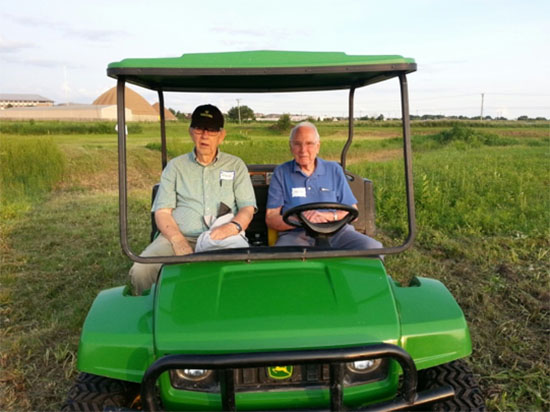
Bill Whiteside (L) and Chris Doll (R) at the at the St. Charles Horticulture Research Center Twilight Meeting in July, 2014.
Richard Hentschel (630-584-6166; hentschel@illinois.edu)
In southern Illinois ... After a rather long spell without rain, the end of last week we finally had some much needed rainfall. Rainfall totals varied anywhere from 1 inch to over 3 inches. This greatly helped out many of our crops which in some areas were very much hurting for rain. I had some later-planted sweet corn that had fairly small ears and poor fill on ears do to the lack of soil moisture.
We are in the midst of peach harvest, and growers have been very satisfied with yields and fruit quality. Periods of cooler temperatures have slowed harvest of tomatoes and some other vegetables. However, given the lack of soil moisture these temperatures have prevented excessive water stress that otherwise would have caused major stress on the plants had it been up in the mid-90s throughout all of July and early August.
Pumpkins are really taking off, and vines are closing in rows and are setting lots of fruit, especially with the recent rains. I've noticed my first squash bugs on pumpkins and also some cucumber beetles as well, so make sure you are scouting and managing for these insects. Also on pumpkins I was very disturbed to find certain pumpkin plants in our variety demonstration plots for Pumpkin Field Day were wilting and dying. Closer inspection would show that the plants had been chewed off at the base and I am assuming by voles or mice. Traditionally, these creatures had been more problematic to seeds than to plants. This situation was particularly odd to me, as the injury did not occur until 3 weeks after transplanting when many plants were already putting on lots of new growth. Also out of the 54 varieties in the plot, they showed a strong preference for the C. maxima varieties such as Blue Jarradale and One Too Many, while not bothering the C. pepo (Jack O Lantern) or C. moschata (Buckskin, processing type). We also had some issues with predation of seeds on Blue Jarradale when we were seeding transplants as well. So always be very observant and scout these, especially if you have had issues with mice and voles in the past!
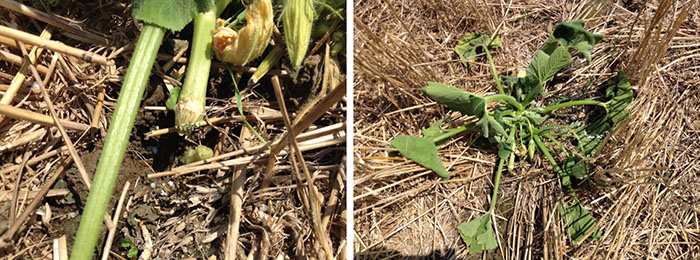
Suspected mouse/vole injury on pumpkin plants.
Nathan Johanning (618-939-3434; njohann@illinois.edu)
From western Illinois ... Rainfall has been very scattered in the area all summer, with some receiving adequate amounts while others were just a few days away from stressful crop conditions. In the immediate Quincy area we've received three "just in the nick of time" rains this summer, just a day or two after we could see corn fields rolling or soybean fields with wilted leaves on lighter soils. The first occurred June 3, the second on July 25, and the last on August 7. Field crops look excellent at this time. Vegetable crops also look great. We won't be irrigating outdoor crops for some time here, as I recorded almost 3" of rain August 6-8. And for the first time in 5 days, the sun actually shone Monday morning.
Local gardeners are beginning to harvest their tomatoes, so there's currently a glut in the market. Same with sweet corn, zucchini and some other crops. Prices are showing degrees of softening.
Pumpkins have been slow to develop. The near-record cold in July, accompanied by dry soils (until recently) and now no sunlight, is causing some concern among growers who attempt to have pumpkins early in September. Some of ours are just now beginning to set fruit, and we usually figure 6 weeks between pollination and fruit. I recently found some squash bug nymphs that were almost as large as the adults, which would indicate they have been around for some time. Scout pumpkins, squash, gourds, etc. for the nymphs and adults as well as the egg masses and treat when necessary.
Isolated powdery mildew infections can be found on cucurbit crops (pumpkin, cucumber, zucchini, etc.). Once the infection is found on leaves, it has reached the epidemic stage according to Dr. Mohammad Babadoost. He has provided control recommendations for pumpkins, which can be found at: http://web.extension.illinois.edu/smallfarm/cat131_4044.html.
Now is the time to be considering a cover crop, especially on those portions of fields where a crop has been harvested. In fact, if you want to raise a nitrogen-producing cover crop and you didn't plant this spring, now is the time to seed. You need to decide what you want the cover crop to accomplish. To build soil nitrogen for next year? Or as a quick cover to suppress weeds? Do you want it to winter kill so you can till/plant that area early next year? Remember that there are positives and negatives for cover crops. One of the hardest ones to figure out is soil moisture. Cereal rye, which can grow to over 6' in height, can utilize a lot of moisture. And in dry springs, you have to really be cautious. Similarly, in wet springs, when the cereal rye is 6' tall, the soil will be very slow to dry out enough to work. Also be cautious of voles. Populations can escalate in a cover crop where food and cover are provided. Vole populations in our area seem to be at an all-time high. A good resource to help evaluate potential cover crops is the Midwest Cover Crop web site: http://www.mccc.msu.edu/.
Japanese beetles are small in number, but in some crops, such as blackberries and grapes, the populations are cause for concern, and sprays have been necessary to protect crops. Nearly all floricane blackberries were lost to the winter cold, but primocane are blooming and setting fruit with some early harvest.
Mike Roegge (217-223-8380; roeggem@illinois.edu)
Fruit Production and Pest Management
Spotted wing Drosophila Update
Our spotted wing Drosophila traps continue to capture adults ... the total number of SWD flies captured in 9 traps in unsprayed areas of the University of Illinois Fruit Research Farm are shown in the graph below. We also sample various fruits on a weekly basis; we extract larvae from fruit samples and hold a second portion of the same samples for adult emergence. So far, SWD has infested nearly all the fruits we have sampled, including blackberry, elderberry, grapes, pokeweed berries, and red, black, and yellow raspberries. Our initial samples of aronia have not been infested, but the fruits we have collected have been from landscape varieties and are not yet ripe.
Observations from a few farms suggest that spray intervals need to be shorter than the 7 days suggested by early research from other states. For products such as Brigade, Delegate, and Mustang Max (all labeled for use on brambles), spray intervals probably should not exceed 5 days.
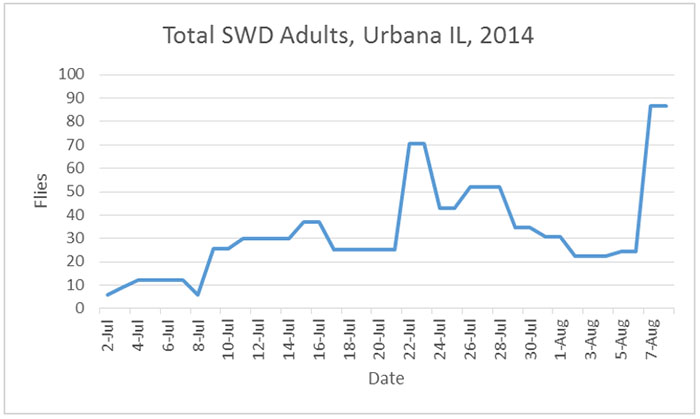
Preharvest Intervals for Apple Insecticides
Apple harvest will not begin for some time, but it's probably time to think about preharvest intervals for insecticides that will be used as harvest approaches. Labels clearly state preharvest intervals (the required time between last application and harvest) for each crop to which an insecticide may be applied. Obeying these preharvest restrictions assures that residues that remain on fruit at harvest will not exceed established tolerances.
Codling moth flight, egg-laying, and larval entry into fruits extend well into the harvest season, and applying insecticides can be necessary through much of September for late-harvested varieties. Preharvest intervals for some of the commonly used and effective insecticides for codling moth control in apples include ...
Altacor | 5 days |
Assail | 7 days |
Belt | 14 days |
Calypso | 30 days |
Delegate | 7 days |
Entrust (OMRI | 7 days |
Rimon | 14 days |
Rick Weinzierl (217-244-2126; weinzier@illinois.edu)
Vegetable Production and Pest Management
Herbicides and Weed Management in No-till Pumpkin Production
This picture is a great illustration of the importance of keeping your field clean of even small weeds at planting, in this case ahead of no-till pumpkin production. This is in wheat stubble after harvest, and the left is an untreated area and the right had a burndown application of Gramoxone 2 SL, Dual II Magnum and Sandea (paraquat, s-metolachlor, halosulfuron) + Nonionic Surfactant about 3 weeks prior. At application the field was relatively clean of weeds at first glance, however, there were many small weeds and those not germinated yet that were controlled by the herbicide application. The predominant weeds in this field were marestail and waterhemp. Refer to the 2014 Midwest Vegetable Production Guide for more specifics on herbicides available for use in the production of various vegetable crops.
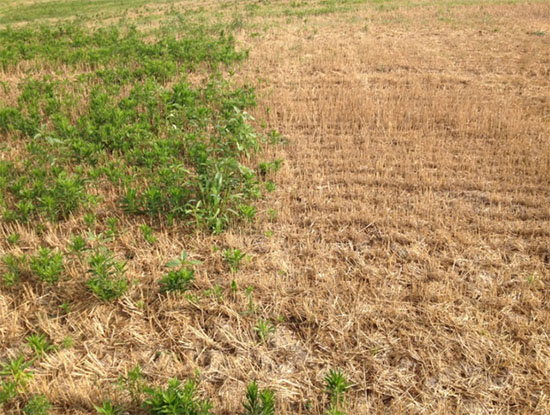
Nathan Johanning (618-939-3434; njohann@illinois.edu)
Corn Earworm Update
Corn earworm flights have remained light in most of Illinois through early August. Counts from our traps at Urbana are summarized below. The light flights and low pressure has been good news for sweet corn and tomato growers. Even so, I offer the following cautions for the remainder of the season ... monitor traps and treat as needed. Some not-too-effective insecticides and spray programs may seem to have worked very well when there would have been little damage anyway. If flights to pick up for the remainder of the sweet corn and tomato season, moths will put all their eggs into these crops (because field corn silking has ended and that crop is no longer attractive to egg-laying corn earworm moths.
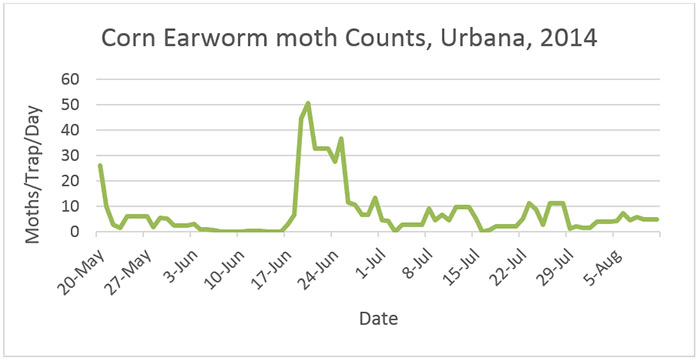
Rick Weinzierl (217-244-2126; weinzier@illinois.edu)
Local Foods Issues
Farmers Market Regulations - Webinars on current and future farmers market regulations
Two webinars, Monday, August 25, 1:00 – 2:30 p.m., and Thursday, August 28, 6:00 – 7:30 p.m., will provide an opportunity for farmers market vendors and farmers market managers to learn about new regulations and reforms that impact farmers markets and provide input to the Governor-appointed Illinois Farmers Market Task Force about future farmers market regulations. This year the Illinois General Assembly passed and Governor Quinn signed into law HB5657, Smarter Rules for Farmers Markets, that made a number of reforms to farmers market regulations in Illinois to support consistency, transparency and economic opportunity. These webinars will provide an overview of the reforms that HB5657 made and what farmers and market managers need to know about the new law. Additionally, the Illinois Farmers Market Task Force is currently reviewing all regulations for farmers markets in the state and will make recommendations for changes at the end of this year. Farmers, farmers market managers, and others have an opportunity to provide input on farmers market regulations including the following topics: products sold at the farmers market, hand-washing stations, refrigeration, sampling, and more.
Both webinars will have the same content. For those who are unable to attend one of these webinars, written comments can be submitted Illinois Stewardship Alliance at isa@ilstewards.org or 230 Broadway, Suite 200, Springfield, IL 62701. To register for the webinar, see https://web.extension.illinois.edu/registration/?RegistrationID=10728 or call the Sangamon Menard Extension office at (217) 782-4617.
The webinars are sponsored by Illinois Stewardship Alliance, Illinois Farmers Market Association and University of Illinois Extension. Questions? Call Illinois Stewardship Alliance at (217) 528-1563 or email isa@ilstewards.org.
Deborah Cavanaugh-Grant (217-782-4617; cvnghgrn@illinois.edu)
Less Seriously ...
Administrator to faculty member: "You have been so successful at doing more with less; now I want you to do everything for nothing."
In a rapidly changing future world, learners will be flexible, adaptable, and successful. The learned will know all there is to know about a past that is no longer relevant.
University of Illinois Extension Specialists in Fruit and Vegetable Production & Pest Management
Extension Educators – Local Food Systems and Small Farms |
||
Bronwyn Aly, Gallatin, Hamilton, Hardin, Pope, Saline, and White counties |
618-382-2662 |
|
Katie Bell, Franklin, Jackson, Perry, Randolph, & Williamson counties |
618-687-1727 |
|
Sarah Farley, Lake & McHenry counties |
847-223-8627 |
|
Nick Frillman, Woodford, Livingston, & McLean counties |
309-663-8306 |
|
Laurie George, Bond, Clinton, Jefferson, Marion, & Washington counties |
618-548-1446 |
|
Zachary Grant, Cook County | 708-679-6889 | |
Doug Gucker, DeWitt, Macon, and Piatt counties |
217-877-6042 |
|
Erin Harper, Champaign, Ford, Iroquois, and Vermillion counties |
217-333-7672 |
|
Grace Margherio, Jackie Joyner-Kersee Center, St. Clair County |
217-244-3547 |
|
Grant McCarty, Jo Daviess, Stephenson, and Winnebago counties |
815-235-4125 |
|
Katie Parker, Adams, Brown, Hancock, Pike and Schuyler counties |
217-223-8380 |
|
Kathryn Pereira, Cook County |
773-233-2900 |
|
James Theuri, Grundy, Kankakee, and Will counties |
815-933-8337 |
|
Extension Educators – Horticulture |
||
Chris Enroth, Henderson, Knox, McDonough, and Warren counties |
309-837-3939 |
|
Richard Hentschel, DuPage, Kane, and Kendall counties |
630-584-6166 |
|
Andrew Holsinger, Christian, Jersey, Macoupin, & Montgomery counties |
217-532-3941 |
|
Extension Educators - Commercial Agriculture |
||
Elizabeth Wahle, Fruit & Vegetable Production |
618-344-4230 |
|
Nathan Johanning, Madison, Monroe & St. Clair counties |
618-939-3434 |
|
Campus-based Extension Specialists |
||
Kacie Athey, Entomology |
217-244-9916 |
|
Mohammad Babadoost, Plant Pathology |
217-333-1523 |
|